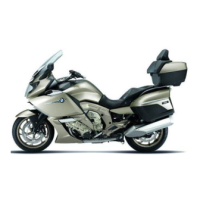Tires
New tires have a smooth sur-
face. This must be roughened by
riding in a restrained manner at
various heel angles until the tires
are run in. This running in proce-
dure is essential if the tires are to
achieve maximum grip.
New tires do not provide
full tire traction. Accident
hazards exist in particular on wet
roads and at extreme angles.
Always think well ahead and
avoid extreme angles.
Brakes
How do you achieve
the shortest stopping
distances?
The dynamic load distribution be-
tween the front and rear wheel
changes during braking. The
heavier you brake, the greater
the weight transfer to the front
wheel. Increases in the load at
an individual wheel are accom-
panied by a rise in the effective
braking force that the wheel can
provide.
To achieve the shortest possible
braking distance, the front brake
must be applied quickly and with
increasing force. This procedure
provides ideal exploitation of the
extra weight transfer to the front
wheel. The clutch should also be
disengaged at the same time.
With the "forced braking" of-
ten practiced in which the brake
pressure is generated as quickly
as possible and with great force,
the dynamic load distribution
cannot follow the increased de-
celeration and the braking force
cannot be completely transferred
to the road surface.
BMW Motorrad Integral ABS pre-
vents the front wheel from lock-
ing.
Descending mountain
passes
There is a danger of the
brakes fading if you use
only the rear brakes when
descending mountain passes.
Under extreme conditions, the
brakes could overheat and suffer
severe damage.
The BMW integrated braking
function ensures that the rear
wheel brake is also applied when
the handbrake lever is actuated,
thus providing protection against
overheating. Simply apply the
front wheel brake and use the
engine brake.
Wet, soiled brakes
Moisture and dirt on the brake
disks and the brake pads result in
a decrease in the braking action.
Delayed or poorer braking action
must be expected in the follow-
ing situations:
5
81
z
Riding

